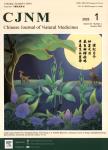Zhongfeng Xingnao Liquid ameliorates post-stroke cognitive impairment through sirtuin1(SIRT1)/nuclear factor erythroid 2-related factor 2(Nrf2)/heme oxygenase 1(HO-1) pathway
作者机构:State Key Laboratory of Southwestern Chinese Medicine Resources Chengdu University of Traditional Chinese Medicine Institute of Material Medica Integration and Transformation for Brain Disorders Chengdu University of Traditional Chinese Medicine School of Pharmacy Chengdu University of Traditional Chinese Medicine Emergency Department Hospital of Chengdu University of Traditional Chinese Medicine
出 版 物:《Chinese Journal of Natural Medicines》 (中国天然药物(英文版))
年 卷 期:2025年第23卷第1期
页 面:77-89页
核心收录:
学科分类:1008[医学-中药学(可授医学、理学学位)] 1006[医学-中西医结合] 100602[医学-中西医结合临床] 10[医学]
基 金:supported by the Science & Technology Department of Sichuan Province (No. 2019YFS0040) the Improvement Plan of “Xinglin Scholar” Scientific Research Talent,Chengdu University of Traditional Chinese Medicine (No.XKTD2022002)
主 题:Apoptosis Mitochondrial function Oxidative stress Post-stroke cognitive impairment Sirtuin1/nuclear factor erythroid 2-related factor 2/heme oxygenase 1 pathway Zhongfeng Xingnao Liquid
摘 要:The activation of the sirtuin1(SIRT1)/nuclear factor erythroid 2-related factor 2(Nrf2)/heme oxygenase 1(HO-1) pathway has been shown to mitigate oxidative stress-induced apoptosis and mitochondrial damage by reducing reactive oxygen species(ROS) levels. Clinical trials have demonstrated that Zhongfeng Xingnao Liquid(ZFXN) ameliorates post-stroke cognitive impairment(PSCI). However, the underlying mechanism, particularly whether it involves protecting mitochondria and inhibiting apoptosis through the SIRT1/Nrf2/HO-1 pathway, remains unclear. This study employed an oxygen-glucose deprivation(OGD) cell model using SHSY5Y cells and induced PSCI in rats through modified bilateral carotid artery ligation(2VO).The effects of ZFXN on learning and memory, neuroprotective activity, mitochondrial function, oxidative stress, and the SIRT1/Nrf2/HO-1 pathway were evaluated both in vivo and in vitro. Results indicated that ZFXN significantly increased the B-cell lymphoma 2(Bcl2)/Bcl2-associated X(Bax) ratio, reduced terminal deoxynucleotidyl transferase-mediated d UTP nickend-labeling(TUNEL)+ cells, and markedly improved cognition, synaptic plasticity, and neuronal function in the hippocampus and cortex. Furthermore, ZFXN exhibited potent antioxidant activity, evidenced by decreased ROS and malondialdehyde(MDA) content and increased superoxide dismutase(SOD), catalase(CAT), and glutathione(GSH) levels. ZFXN also demonstrated considerable enhancement of mitochondrial membrane potential(MMP), Tom 20 fluorescence intensity, adenosine triphosphate(ATP) and energy charge(EC) levels, and mitochondrial complex Ⅰ and Ⅲ activity, thereby inhibiting mitochondrial damage. Additionally,ZFXN significantly increased SIRT1 activity and elevated SIRT1, nuclear Nrf2, and HO-1 ***, these effects were substantially counteracted when SIRT1 was suppressed by the inhibitor EX-527 in vitro. In conclusion, ZFXN alleviates PSCI by activating the SIRT1/Nrf2/HO-1 pathway and preventing mitochond




